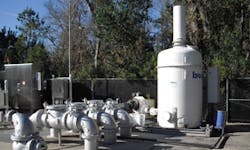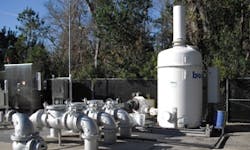Project Validates Biotrickling Odor Control Technology
An extensive research and development project by BioAir Solutions with the assistance of JEA, a Florida-based municipal utility, has validated the company's technology. The project also demonstrated that BioAir's full-scale biotrickling filter can effectively remove hydrogen sulfide and other organic odorous compounds from wastewater treatment airstreams under very high volumetric loading rates in very short residence times.
The findings were part of a technical presentation at the Florida Water Resources Conference held in May.
A recent study demonstrated the ability of the BioAir biotrickling filter to remove hydrogen sulfide at very high volumetric loading rates.
The project demonstrated the biotrickling filter – which uses the company's proprietary EcoBase™ structured synthetic media – can treat the same amount of air as competing technologies, in a unit one-third the size and in one-third the residence time (less than 3 seconds). The data collected during the year long research project at the Florida utility showed that the EcoBase media removed more than 98 percent of all odors, including more than 99.9 percent removal of hydrogen sulfide odors without the use of chemicals or carbon adsorbents.
The synthetic media provides uniform air flow distribution, optimized mass transfer of odor compounds, and a controlled microenvironment enabling the growth and proliferation of specific odor removing bacterial species.
"Since management of air contaminants and odorous compounds from municipal wastewater treatment plants has become a significant activity for the more than 16,000 municipalities in the United States, the findings of this study are very important," said Louis le Roux, president of BioAir Solutions.
Biotrickling filter technology uses a "fixed film" microbial layer that is attached to a medium inside a reactor, which then metabolizes (oxidizes) the odorous constituents into odorless compounds. Since municipal odors consist of both organic and inorganic odors, two different bacteria are used in biotrickling filters.
"The results from this study show that the technology incorporated into BioAir's systems are setting new performance standards for what is achievable with biotrickling filters," said BioAir's le Roux. WW
More WaterWorld Current Issue Articles
More WaterWorld Archives Issue Articles

